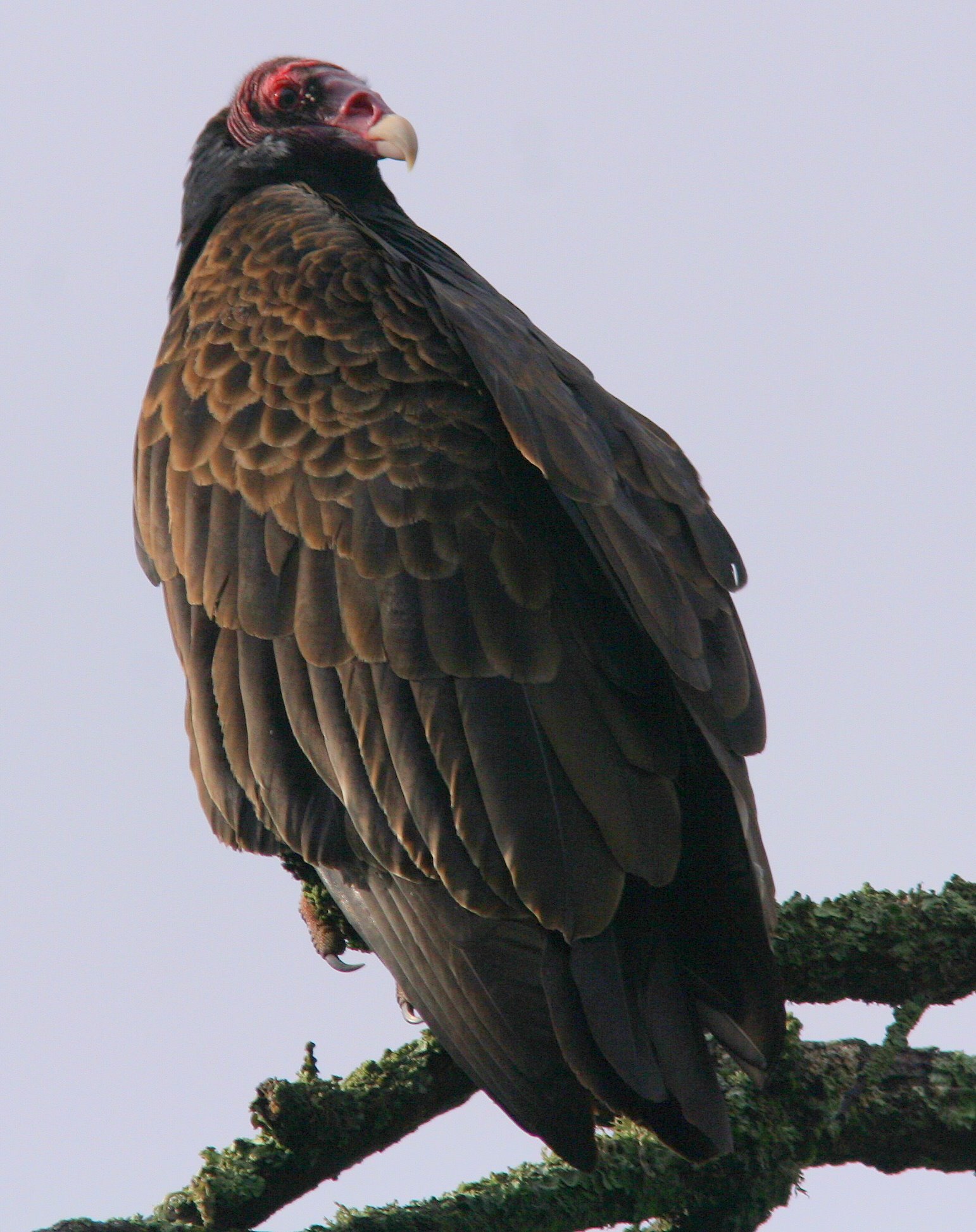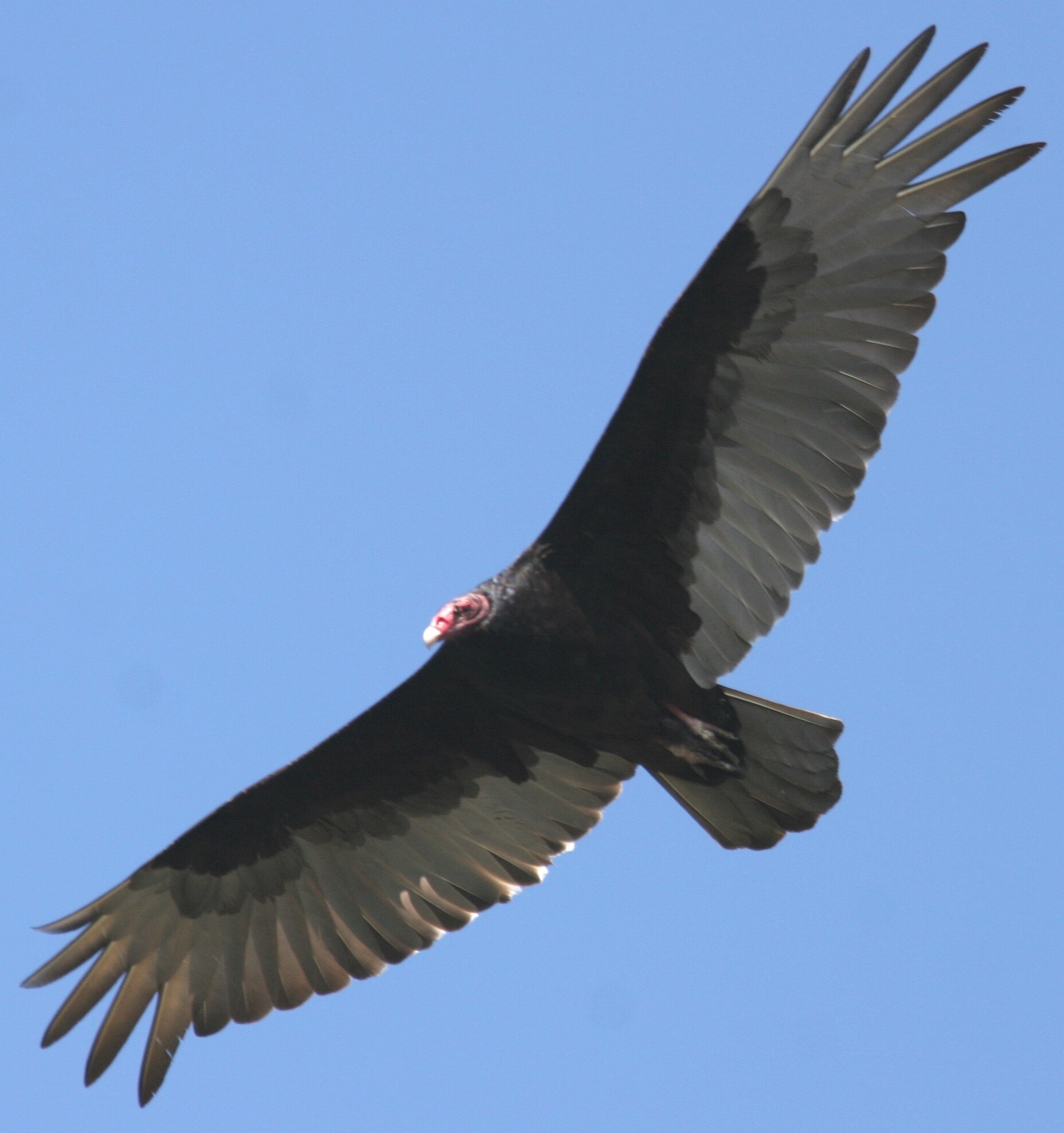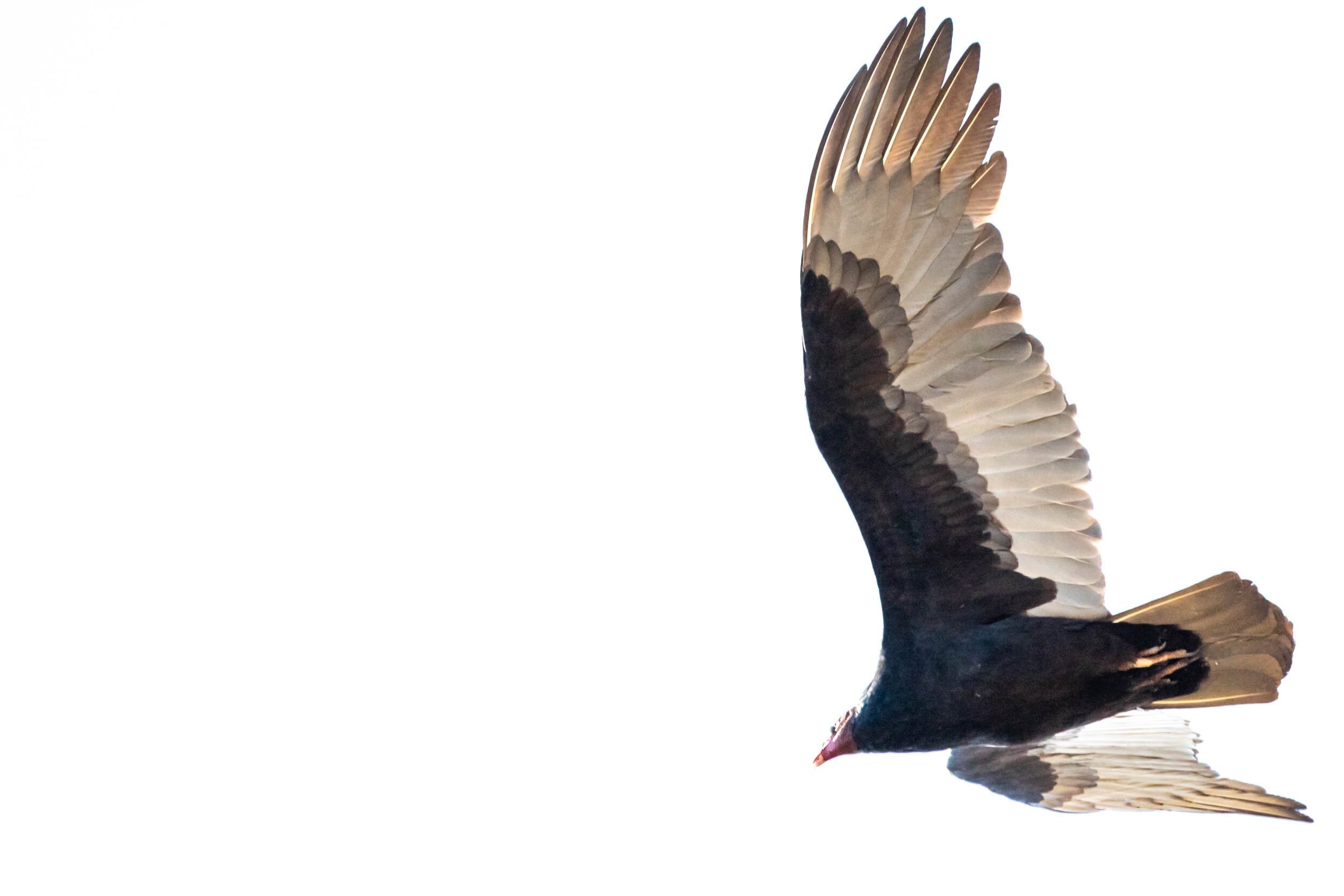Turkey Vulture, Image by Larry Hickey
This month, let’s talk about a common bird found in the Sacramento Valley called the Turkey Vulture (Cathartes aura). In the Fall, northern populations of this species migrate south in large flocks. Some populations remain in certain areas year round, like they do in the Sacramento Valley. Turkey Vultures are truly amazing, beneficial, and mild-mannered birds. They live in many areas, from southern Canada to the southern tip of South America. Turkey Vultures were given their name because their red heads resemble that of male Wild Turkeys.
Let’s clear up some misconceptions (or false ideas) about Turkey Vultures. Some people call them ‘buzzards’. However, this name is not correct. Turkey Vultures are not even related to buzzard species. Buzzards are members of the hawk family and don’t live in the United States! Besides, Turkey Vultures don’t look anything like the true buzzards.
Many people believe that when Turkey Vultures are circling high in the sky that they are looking down on a potential meal. Actually, when they fly in big circles, they are most likely taking advantage of rising air currents or thermals. These warm pockets of air lift the birds so they can glide without using much energy. Since Turkey Vultures are large birds and have huge wingspans, it takes an enormous amount of energy to fly by flapping their wings. Therefore, finding thermals and gliding is a great way to save energy. Turkey Vultures frequently hold their wings in a V-shape. This specific wing position helps them stabilize themselves if they meet up with turbulent air (air moving very strongly and suddenly).
In contrast to many other raptors, Turkey Vultures are fairly social birds. They often fly in small groups in the daytime. In the evening, they usually gather in large groups (or colonies) to roost or rest. Turkey Vultures have been known to share carrion with Black Vultures, eagles, and ravens.
What do Turkey Vultures look like?
Adult Turkey Vulture, Image by Mary Forrestal
The size of a Turkey Vulture is between an eagle and a hawk. Turkey Vultures have long wings, bulky-looking bodies, small heads, and light-colored beaks. When they are flying high in the sky, they may appear black. However, when seen close up, Turkey Vultures’ feathers are actually dark brown. Their head, face, and upper neck is absent of feathers! The bare skin on these areas is generally red, but when relaxed it can appear pale pink or even light blue. Turkey Vultures’ underwings have a divided coloration. The front underwing area is dark; while the rear underwing area is a silvery-gray, as shown in the photo below. Juvenile birds can be distinguished from adults by their gray heads and dark beaks.
Where do Turkey Vultures live?
Adult Turkey Vulture, Image by Chris Conard
Turkey vultures live in many habitats and are seen flying over open countryside such as suburbs, scrublands, landfills, rangeland, and farm fields; but they are also seen in woodland areas and forests. They roost (or rest) on dead tree limbs, fence posts, poles, or towers at night. Turkey vultures are frequently seen in the morning high in trees with their wings spread facing the sun. There are a few theories on why they hold their wings like this: perhaps they get an energy boost from the sun by warming up or the sun may aide in the digestion of their food. Some suggests that the heat from the sun kills parasites that are on their bodies. (Parasites are living things that live or feed on on other living things, such as ticks and fleas.)
Turkey Vulture nests are usually very well hidden. This has made studying the birds’ nesting habits difficult for scientists. Whereas Turkey Vultures will frequently roost and hunt near humans, their nest sites are usually far away from people! Turkey Vultures use sheltered nest sites in logs, rock crevices (spaces between rocks), inside dense bushes or trees, fallen trees, old buildings, and even use old nests of raptors and herons. The carefully selected nest sites tend to be used over-and-over again. Turkey Vultures do not make structured nests. They simply scrape the ground to make a slight depression where the eggs will be.
What do Turkey Vultures eat?
Adult Turkey Vulture, Image by Chris Conard
Turkey Vultures scan the countryside for food as they fly. They mainly eat mammals; but will also eat reptiles, other birds, amphibians, fish, and even invertebrates. Turkey vultures also eat animal bones! Some people worry that Turkey Vultures will swoop down and carry away their pets for food. They need not worry though because Turkey Vultures usually will only eat animals that are dead and starting to decay. They frequently eat dead animals near roadways which have been hit and killed by automobiles. An amazing finding is that Turkey vultures can go without a meal for more than two weeks if they have to!
Decaying animal flesh is called carrion. Eating carrion doesn't sound very appetizing to humans; but it’s nature’s way of keeping the environment clean and free of dead animals. So Turkey Vultures continuously provide a cleaning service for humans and other animals! Without vultures in the ecosystem, there would be more infectious disease spread due to the accumulation of rotting carcasses (the dead bodies of animals) which harbor viruses and bacteria.
Another interesting fact is that Turkey Vultures do not get sick after eating decayed meat or other animal parts. Carrion is toxic (harmful) to most animals. Fortunately for the Turkey Vulture, their gastrointestinal tracts are very acidic and kill most of the microorganisms that are eaten. Scientists have also discovered that Turkey Vultures have an amazing tolerance for many bacteria that are found inside their bodies.
What do Turkey Vultures sound like?
Most of the time, Turkey Vultures are silent birds; but they occasionally hiss or grunt to communicate, especially when they are feeding or around their nests. They can not sing or call like many other birds do because they do not have a voice box or larynx. You can listen to the Turkey vulture below.
These sounds of the Turkey Vulture are from xeno-canto. More Turkey Vulture vocalizations can be found at xeno-canto.org/species/Cathartes-aura.







